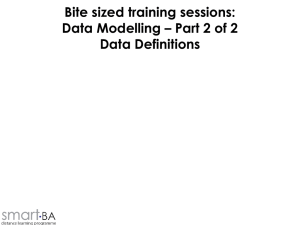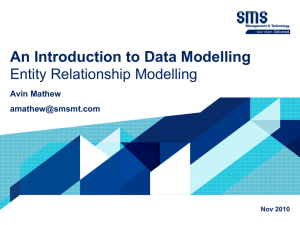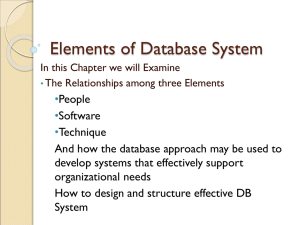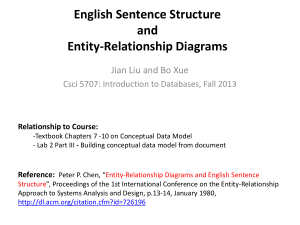Answers to assignment#1
advertisement
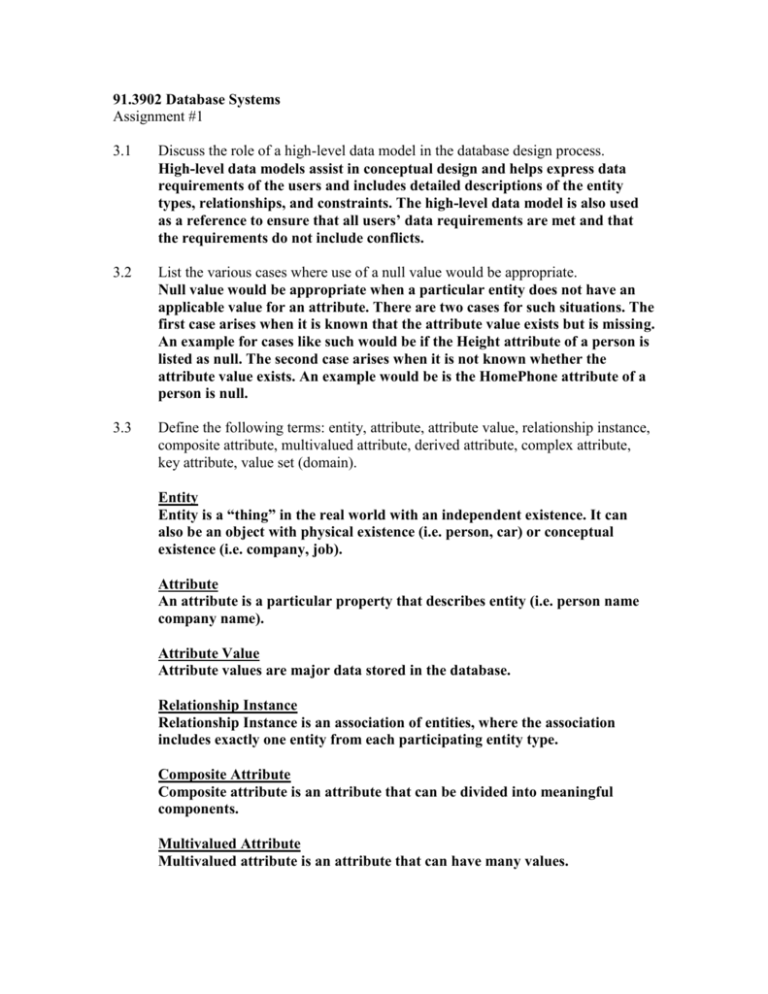
91.3902 Database Systems
Assignment #1
3.1
Discuss the role of a high-level data model in the database design process.
High-level data models assist in conceptual design and helps express data
requirements of the users and includes detailed descriptions of the entity
types, relationships, and constraints. The high-level data model is also used
as a reference to ensure that all users’ data requirements are met and that
the requirements do not include conflicts.
3.2
List the various cases where use of a null value would be appropriate.
Null value would be appropriate when a particular entity does not have an
applicable value for an attribute. There are two cases for such situations. The
first case arises when it is known that the attribute value exists but is missing.
An example for cases like such would be if the Height attribute of a person is
listed as null. The second case arises when it is not known whether the
attribute value exists. An example would be is the HomePhone attribute of a
person is null.
3.3
Define the following terms: entity, attribute, attribute value, relationship instance,
composite attribute, multivalued attribute, derived attribute, complex attribute,
key attribute, value set (domain).
Entity
Entity is a “thing” in the real world with an independent existence. It can
also be an object with physical existence (i.e. person, car) or conceptual
existence (i.e. company, job).
Attribute
An attribute is a particular property that describes entity (i.e. person name
company name).
Attribute Value
Attribute values are major data stored in the database.
Relationship Instance
Relationship Instance is an association of entities, where the association
includes exactly one entity from each participating entity type.
Composite Attribute
Composite attribute is an attribute that can be divided into meaningful
components.
Multivalued Attribute
Multivalued attribute is an attribute that can have many values.
Derived Attribute
Derived attribute is an attribute whose value is computed from another
attribute or combination of attributes.
Complex Attribute
Complex attribute is composite and multivalued attributes nested in an
arbitrary manner.
Key Attribute
Key attribute is an attribute whose values are distinct for each individual
entity in the collection.
Value Set (Domain)
Value set specifies the set of values that may be assigned to that attribute for
each individual entry.
3.4
What is an entity type? What is an entity set? Explain the differences among an
entity, an entity type, and entity set.
Entity type defines a collection of entities that have the same attributes.
Entity set is a named collection of related data. The differences between
entity, an entity type, and entity set are:
1. Entity is a person, place, thing, event, or even a concept. It may be
tangible or intangible. Examples of an entity are employees,
2. Entity type describes the schema or intension for a set of entities that
share the same structure.
3. Entity set is the extension of the entity type.
3.5
Explain the difference between an attribute and a value set.
An attribute is a particular property that describes entity. A value set
specifies the set of values that may be assigned to that attribute for each
individual entry. An example of an attribute is EmployeeAge and we can set
the value set for this attribute to a range of integer numbers.
3.6
What is a relationship type? Explain the differences among a relationship
instance, a relationship type, and a relationship set.
Relationship type is the nature of a relationship between entities, expressed
by the number of their possible occurrences in the related tables. The
differences between a relationship instance, a relationship type, and a
relationship set are:
1. Relationship instance is an association of entities, where the association
includes exactly one entity from each participating entity type.
2. Relationship type defines a relationship set among entities from these
types.
3. Relationship set is a set of associations.
3.7
What is a participation role? When is it necessary to use role name in the
description of relationship type?
Participation role is the part that each entity participates in a relationship. It
is necessary to use role name in the description of relationship type when the
same entity type participates more than once in a relationship type in
different roles. In other words, role names are necessary in recursive
relationships.
3.8
Describe two alternatives for specifying structural constraints on relationship
types. What are the advantages of each.
Two alternatives for specifying structural constraints on relationship types
are cardinality ratio and participation. Cardinality ratio for a binary
relationship specifies the number of relationship instances that an entity can
participate in. The participation constraint specifies whether the existence of
an entity depends on its being related to another entity via the relationship
type.
3.9
Under what conditions can an attribute of a binary relationship type be migrated
to become an attribute of one of the participating entity type?
An attribute of a binary relationship type can be migrated to become an
attribute of one the participating entity type when the relationship type is 1:1
or 1:N. This is because each entity participates in at most one relationship
instance. However, for 1:N relationship type, a relationship attribute can be
migrated only to the entity type at the N-side of the relationship.
3.10
When we think of relationships as attributes, what are the value sets of these
attributes? What class of data models is based on this concept?
The value sets of these attributes
What is meant by a recursive relationship type? Give some examples of recursive
relationship types.
A recursive relationship type exists if an entity can be related to itself or in
other words, the same entity type participates more than once in a
relationship type in different roles. An example of a recursive relationship
type is courses that require one or more other courses as prerequisites. The
course entity is related to another course entity. In this case, the recursive
relationship “course is a prerequisite to course” also happens to be a M:N
relationship. This is because a course can have more than one prerequisite,
and a course can be a prerequisite to many other courses.
3.11
Another example of a recursive relationship type is in a supervision
relationship type between an employee and a supervisor. Both entities are
members of the same Employee entity type. In this example, the employee
entity type participates twice in the supervision relationships, once in the role
of a supervisor, and once in the role of supervisee.
3.12
When is the concept of weak entity used in data modeling? Define the terms
owner entity type, weak entity type, identifying relationship type, and partial key.
The concept of weak entity is used in data modeling when there are many
attributes or when entity types do not have key attributes of their own.
Owner Entity Type
Owner entity type is an entity type that is related to weak entity types
through combination of some of their attribute values.
Weak Entity Type
Weak entity type is an entity type that does not have key attributes of their
own.
Identifying Relationship Type
Identifying relationship type is the relationship type that relates a weak
entity type to its owner.
Partial Key
Partial key is a set of attributes that can uniquely identify weak entities that
are related to the same owner entity.
3.13
Can an identifying relationship of a weak entity type be of a degree greater than
two? Give examples to illustrate your answer.
An identifying relationship of a weak entity type can be of a degree greater
than two. For a ternary identifying relationship type, the weak entity type
has several owner entity types. An example for a ternary relationship such
as Supply must be represented as weak entity type, with no partial key and
with three identifying relationships. These participating entity types
Supplier, Part, and Project are together the owner entity types. Hence, an
entity in the weak entity type Supply is identified by the combination of its
three owner entities from Supplier, Part, and Project.
3.14
Discuss the convention for displaying an ER schema as an ER diagram.
Entity types are shown in rectangular boxes. Relationship types are shown in
diamond-shaped boxes attached to the participating entity types with
straight lines. Attributes are shown in ovals, and each attribute is attached
by a straight line to its entity type or relationship type. Component attributes
of a composite attribute are attached to the oval representing the composite
attribute. Multivalued attributes are shown in double ovals and key
attributes have their names underlined. Derived attributes are shown in
dotted ovals.
Weak entity types are distinguished by being placed in double rectangles and
by having their identifying relationship placed in double diamonds. The
partial key of the weak entity type is underlined with a dotted line.
The cardinality ratio of each binary relationship type is specified by
7attaching a 1, M, or N on each participating edge. The participation
constraint is specified by a single line for partial participation and by double
lines for total participation. We show the role names when one entity type
plays both roles in a relationship.
3.15
Discuss the naming conventions used for ER schema diagram.
Entity types are usually singular names, rather than plural ones, because the
entity type name applies to each individual entity belonging to that entity
type. Entity type and relationship type names are in uppercase letters,
attribute names are capitalized, and role names are in lowercase letters.
Given a narrative description of the database requirements, we usually use
nouns for entity type names, and the verbs to indicate names of relationship
types. Attribute names general arise from additional nouns that describe the
nouns corresponding to the entity types.
Relationship names should be readable from left to right and from top to
bottom.
3.19
Consider the ER diagram of Figure 3.16, which shows a simplified
schema for an airline reservations system. Extract from the ER diagram
the requirements and constraints that produced this schema. Try to be as
precise as possible in your requirements and constraints specification.
Entity Types:
Airport
1. Each airport is identified by AirportCode.
2. We need to keep track of the Name, City, and State for each airport.
Airplane Type
1. Each airplane type is identified by TypeName.
2. We need to keep track of the Max-seats for each airplane type.
Airplane
1. Each airplane is identified by AirplaneId.
2. We need to keep track of the Total-no-of-seats for each airplane.
Flight Leg
1. We need to track of the LegNo for each flight leg.
Flight
1. Each flight is identified by Number.
2. We need to keep track of the Weekdays and Airline for each flight.
Leg Instance
1. We need to keep track of the Date and No-of-avail-seats for each leg
instance.
2. Each leg instance must be assigned to at least one airplane.
3. Each leg instance must be an instance of a flight leg.
Relationships, attributes, and constraints:
1.
Relationship between FLIGHT and FARES
a. Each instance of FLIGHT may offer multiple instances of FARE.
b. Instances of FARE must be sold for a specific instance of FLIGHT.
2.
Relationship between FLIGHT and FLIGHT LEG
a. Each instance of FLIGHT may consist of multiple instances of
FLIGHT LEG.
b. Instances of FLIGHT LEG must belong to a specific instance of
FLIGHT
3.
Relationship between FLIGHT LEG and AIRPORT
(ScheduledDepTime)
a. Each instance of AIRPORT may be scheduled for the departure of
multiple instances of FLIGHT LEG.
b. Instances of FLIGHT LEG must be scheduled for departure from a
specific instance of AIRPORT.
4.
Relationship between FLIGHT LEG and AIRPORT
(ScheduledArrTime)
a.
Each instance of AIRPORT may be scheduled for the arrival of
multiple instances of FLIGHT LEG.
b.
Instances of FLIGHT LEG must be scheduled for arrival at a specific
instance of AIRPORT.
5.
Relationship between FLIGHT LEG and LEG INSTANCE
a.
Each instance of FLIGHT LEG may consist of instances of LEG
INSTANCE.
b.
Instances of LEG INSTANCE must be instances of FLIGHT LEG.
6.
Relationship between LEG INSTANCE and AIRPORT (ArrTime)
a.
Each instance of AIRPORT may accommodate the arrival of multiple
instances of LEG INSTANCE.
b.
Instances of LEG INSTANCE must arrive at a specific instance of
AIRPORT.
7. Relationship between LEG INSTANCE and AIRPORT (DepTime)
a. Each instance of AIRPORT may accommodate the departure of
multiple instances of LEG INSTANCE.
b. Instances of LEG INSTANCE must depart from a specific instance of
AIRPORT.
8.
Relationship between LEG INSTANCE and SEAT (CustomerName,
CPhone)
a.
Each instance of LEG INSTANCE may have multiple instances of
SEAT for reservation.
b.
Instances of SEAT must be reserved for a specific instance of LEG
INSTANCE.
9.
Relationship between AIRPLANE and LEG INSTANCE
a.
Each instance of AIRPLANE may be assigned to multiple instances of
LEG INSTANCE.
b.
Instances of LEG INSTANCE must have a specific instance of
AIRPLANE assigned to them.
10.
Relationship between AIRPLANE TYPE and AIRPLANE
a.
Each instance of AIRPLANE TYPE may consist of multiple instances
of AIRPLANE.
b.
Instances of AIRPLANE must belong to a specific instance of
AIRPLANE TYPE.
11.
Relationship between AIRPORT and AIRPLANE TYPE
a.
Multiple instances of AIRPORT may be available for multiple
instances of AIRPLANE TYPE for landing.
b.
Multiple instances of AIRPLANE TYPE may land at multiple
instances of AIRPORT.
3.21 Design an ER diagram for keeping track of information about votes taken in the U.S.
House of Representatives during the current two-year congressional session…. Draw an
ER schema diagram for the above application. State clearly any assumption you make.
Entities:
STATE
Name, RegionOfState
CONGRESSPERSON
Name (FName, MInit, LName), District, StartDate, PoliticalParty
BILL
BillName, PassedOrFailed,
district
name
StartDate
congressperson N
N
M
sponsor
vote
PolParty
represent
StateName
1
StateRegion
state
DateOfVote
N
M
Bill
BillName
3.21
PassedOrFailed
Design an ER diagram for keeping track of information about votes taken in the
U.S. House of Representatives during the two-year congressional session. The
database needs to keep track of each U.S. state’s Name (e.g. Texas, New York,
California) and includes the region of the state (whose domain is {North East,
Midwest, Southwest, West}). Each CONGRESSPERSON in the House of
Representatives us described by their Name, and includes the District represented,
the StartDate when they were first elected, and the political Party they belong to
(whose domain is {Republican, Democrat, Independent, other}). The database
keeps track of each BILL (i.e. proposed law), and includes the BillName, the
DateOfVote on the bill, whether the bill PassedOrFailed (whose domain is {YES,
NO}), and the sponsor (the congressperson(s) who sponsored – i.e., proposed –
the bill). The database keeps track of how each congressperson voted on each bill
(domain of vote attribute is {Yes, No, Abstain, Absent}). Draw an ER schema
diagram for the above application. State clearly any assumption you make.
3.22
A database is being constructed to keep track of the teams and games of a sport
league. A team has a number of players, not all of whom participate in each game.
It is desired to keep track of the players participating in each game for each team,
the positions they played in that games, and the result of the games. Try to design
an ER schema diagram for this application, stating any assumption you make.
Choose your favourite sport (soccer, baseball, football …)
GameNum
Result
me
Game
Team
eamName
N
M
sponsor
NumOfPlayers
L
Players
PlayerName
Position


